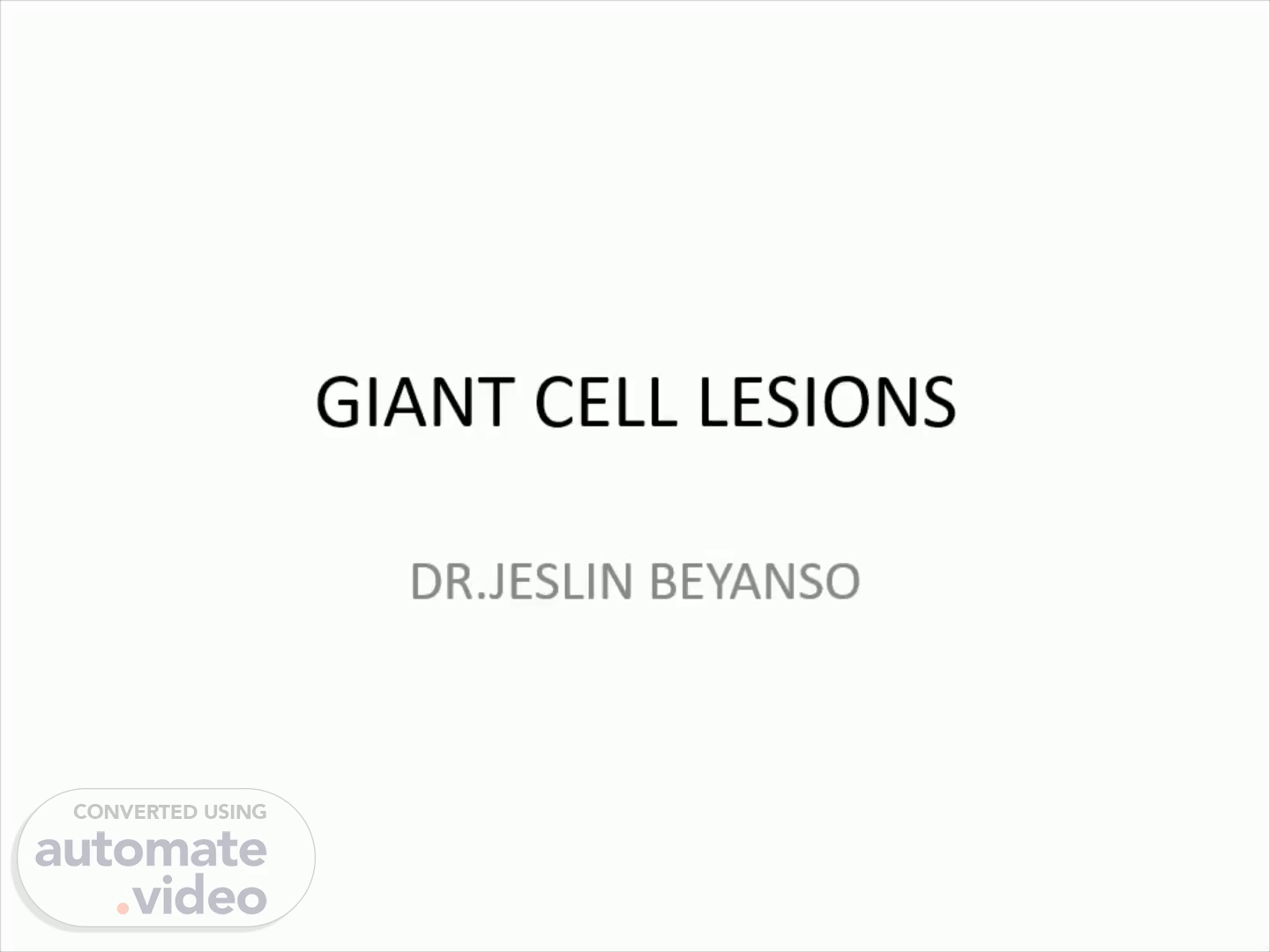Scene 1 (0s)
GIANT CELL LESIONS. DR.JESLIN BEYANSO.
Scene 2 (7s)
DEFINITION. First described by VIRCHOW. Giant cells are unusually large, multinucleated, modified macrophages which may be formed by coalescence of mononuclear cells or by nuclear division without cytoplasmic division of monocytes , particularly in response to the presence of a foreign body..
Scene 3 (21s)
Classification of giant cells. PHYSIOLOGIC PATHOLOGIC OSTEOCLAST IN BONE 1.FOREIGN BODY GIANT CELLS 2. TROPHOBLAST IN PLACENTA 2.LANGHAN’S GIANT CELLS 3. MEGAKARYOCYTES IN BONE MARROW 3.TOUTON GIANT CELLS 4.STRIATED MUSCLE 4.TUMOR GIANT CELLS 5.WARTHIN FINKELDEY GIANT CELLS.
Scene 4 (37s)
Cells with nuclei are arranged in 'HORSESHOE' shaped pattern. Can be seen in one or both the poles Langhans NOT Langerhans! Contain regular nuclei scattered throughout cytoplasm Ring of nuclei surrounding central cytoplasm. peripheral cytoplasm is vacuolated Foreign body Touton Contain hyperchromatic pleomorphic nuclei scattered throughout cytoplasm Tumor.
Scene 5 (47s)
FORMATION OF GIANT CELLS. FUSION MEDIATED BY IMMUNE SYSTEM FUSION FROM RECOGNITION OF AN ABNORMAL MACROPHAGE SURFACE BY YOUNG MACROPHAGES FUSION DUE TO ENDOCYTIC ACTIVITY.
Scene 6 (58s)
INDIVIDUAL MONOCYTES LANGHAN GIANT CELL FOREIGN BODY GIANT CELL FUSION OF MONOCYTES.
Scene 7 (1m 5s)
FUSION MEDIATED BY IMMUNE SYSTEM Lymphokines and membrane changes on the cell wall will facilitate the adherence and fusion of macrophages..
Scene 8 (1m 15s)
FUSION FROM RECOGNITION OF AN ABNORMAL MACROPHAGE SURFACE BY YOUNG MACROPHAGES Chromosomal abnormalities abnormal cell surface+ young macrophage=fusion.
Scene 9 (1m 24s)
FUSION DUE TO ENDOCYTIC ACTIVITY An endosome margin is formed when antigen attaches to the surface of the macrophage. One endosome margin fuses with the other. giant cell.
Scene 10 (1m 35s)
Classification of giant cell lesions. Based on etiopathogenesis I. Chattopadhyay , 1995 A. Where giant cells are present in the concerned background and are pathognomic : 1. Hodgkin’s lymphoma 2. Peripheral giant cell granuloma 3. Giant cell fibroma 4.Giant cell tumor B. Where giant cells are characteristic, but not pathognomic :‑ 1. Tuberculosis 2. Herpes simplex virus infection 3. Measles 4. Xanthoma C. Diseases associated with the presence of giant cells: 1. Orofacial granulomatosis 2. Fungal infection foreign body reactions 3. Neoplasms 4. Syphilis 5. Leprosy 6. Fibrous dysplasia.
Scene 11 (2m 3s)
7. Cherubism 8. Paget’s disease of the bone 9. Aneurysmal bone cyst 10. Ossifying fibroma 11. Wegener’s granulamatosis 12. Actinomycoses 13. Chronic diffuse sclerosing osteomyelitis 14. Odontogenic giant cell fibromatoses 15. Heerfordt’s syndrome..
Scene 12 (2m 17s)
GIANT CELL LESIONS OF JAW. INFLAMMATORY/REACTIVE: Peripheral giant cell granuloma Central giant cell granuloma Aneurysmal bone cyst Traumatic bone cyst METABOLIC: Hyperparathyroidism Cherubism Histiocytosis NEOPLASTIC Central giant cell tumor Osteoid osteoma / osteoblastoma Hodgkin’s lymphoma.
Scene 13 (2m 30s)
CENTRAL GIANT CELL GRANULOMA.
